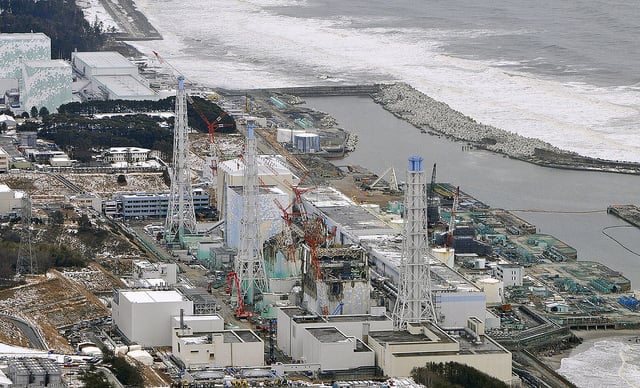
The ashes of the Fukushima Daiichi nuclear plant and workers still cleaning up the destruction (Photo: SimplyInfo via Flickr).
Following the release of Japanese Prime Minister Shinzo Abe’s new energy plan, nuclear reactors are set to restart across the island nation three years after the Fukushima disaster, leaving many fearing another radioactive plume.
Citing economic and environmental concerns, Abe unveiled his government’s 20-year Basic Energy Plan on February 25, which aims to restart at least some of Japan’s 48 dormant reactors shut down shortly after the Fukushima Daiichi nuclear meltdown in 2011. The plan stands in stark opposition to the commitment Abe’s predecessor, former Prime Minister Naoto Kan, promised in the months following the disaster and rare mass protests against nuclear energy.
Before the accident, nuclear energy powered close to 30 percent of Japan’s energy needs, slated to increase to 50 percent by 2030. According to the World Nuclear Association, Japan currently imports about 84 percent of its energy. Since Japan turned off its reactors, electricity generation costs have risen by more than 50 percent due to the country’s large amount of oil and natural gas imports.
Radioactive history
This is not the first time Japan has faced energy problems. A lack of natural resources prompted Japan to aggressively seek control of vital assets in China and the Pacific in the lead up to World War II.
Ironically, after Japan became the only country to ever experience a wartime atomic attack, it embraced nuclear energy as a way to efficiently bring cheap energy to its people in 1966 when its first reactor went online. Realizing the potential of nuclear, Japan heavily invested in reactors across its islands, giving way to the rise of powerful companies, such as Fukushima’s owner, the Tokyo Electric Power Company (TEPCO).
But on March 11, 2011, an 8.9 magnitude earthquake rumbled off the east coast of Honshu, the nation’s largest island. The seismic activity sent a tsunami barreling to the coast, which shook the foundations of Fukushima to its breaking point.
The tsunami’s floods, not the earthquake’s force, broke vital cooling systems in several of the plants reactors causing meltdowns that resulted in radioactive contamination by air and sea. Fallout from Fukushima–the worst since the Chernobyl incident in 1986–covered eight percent of Japan in a radioactive plume, displacing 340,000 people, and few have yet returned. Around 19,000 people died from the earthquake and tsunami, but there have been no reported deaths from radiation contamination.
The cost of the earthquake, tsunami and nuclear disaster totaled around $5.5 billion, though cleanup work continues at Fukushima. On the same day Prime Minister Abe released the Basic Energy Plan, a damaged power cable caused a cooling system at Fukushima to fail, forcing workers to pause their dismantling of a wrecked storage pool.
Nuclear necessity
In 2013, Japan increased crude oil shipments by 16 percent due to its lack of natural resources and minimal renewable energy production, leading to a $113 billion trade deficit that was double from the previous year.
“It’s hard to anticipate when Japan can emerge from trade deficits at this point,” Chief Economist at Norinchukin Research Institute Takeshi Minami told Bloomberg News. “If a trade deficit as a result of high energy import costs makes Japan look like a high-cost country, it may discourage moves by companies to have production centers in Japan and undermine Abenomics.”
Prime Minister Abe, who was elected on a platform of economic reform, envisions nuclear power as a way to cure Japan’s energy shortage but only if reactors meet heightened safety standards.
The Japanese government established the Nuclear Regulation Authority in 2012 as a watchdog group to perform inspections on idle reactors before they are permitted to go online. The NRA’s role is to establish regulatory requirements for nuclear safety and examine whether power plants meet those guidelines.
The Basic Energy Plan suggested restarting reactors for environmental benefits as well. The Washington Post said Prime Minister Abe’s report described nuclear power as a reliable source that “emits no greenhouse gas.”
Renewables
The anti-nuke opposition in Japan is hoping their country will follow in the footsteps of Chancellor Angela Merkel’s Germany.
Stunned by the radiation Fukushima was seeping into the world’s air and ocean streams, Chancellor Merkel announced an accelerated phasing out of Germany’s 17 nuclear reactors by 2022. Chancellor Merkel’s ambitious goal means that 81 million Germans will be dependent on wind, solar and geothermal for most of their energy needs.
Those in Japan who most fear another Fukushima accident are urging their government to take the same initiative.
Though renewable energy accounted for only 1.6 percent of Japan’s generated power in 2012, its potential is much greater. According to EY, Japan moved past the United Kingdom in 2014 as the fourth-most attractive country to develop renewable energy. The new 70-megawatt Kagoshima Nanatsujima solar plant, Japan’s largest, is giving credit to this potential.
Back online
Japan’s cabinet will now vote on whether to accept the Basic Energy Plan. The vote will take place in March, though most expect it to easily pass.
If the plan passes the vote and power plants pass inspection, Prime Minister Abe is hoping to restart reactors by summer 2014.
Although many throughout Japan’s islands are hesitant to embrace nuclear energy as the key to its economic future, Prime Minister Abe is ensuring heightened safety and renewable investments will make nuclear a temporary solution and not the forefront of energy production.
“Our dependence on imported oil is now higher than during the oil shock of 1973,” an official in the Ministry of Economy, Trade and Industry told NPR. “We cannot say we’re enjoying a stable energy supply now.”